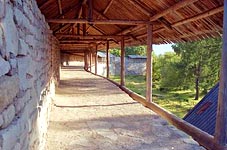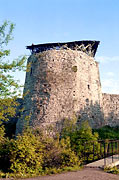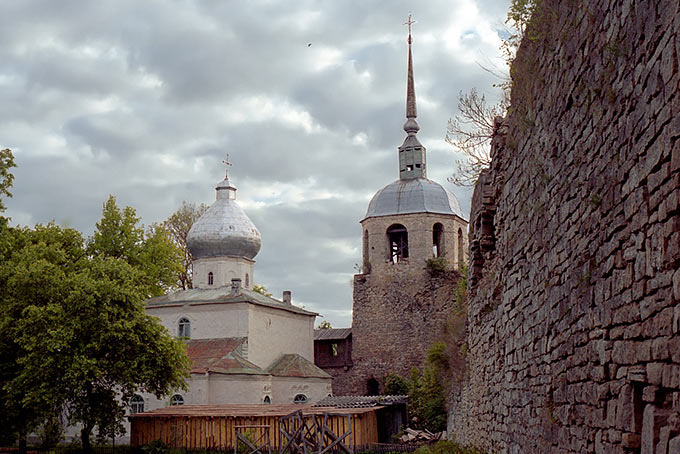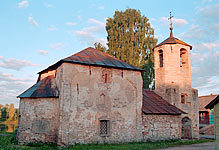History of the Porkhov Fortress
The First record about Porkhov fortress was made in Novgorod's chronicles in 1239. Knight of Novgorod Alexander Jaroslavovitch (which was called "Nevskij" afterward) established the trade way along Shelonj river from Novgorod to Pskov by building of small wooden strong points. Porkhov fortress was one of them. Its fortifications consisted two lines of earthen ramparts and ditches and wooden wall above the ramparts.
In 1346 Great Lithuanian knight Olgerd invaded the Novgorod's territory and took by storm fortress Luga and Shelonj and sieged fortress Opocka and Porkhov. Porkhov stood its first test. Lithuanians got the war indemnity in 300 rubles from the fortress and got away.
In 1387 a new stone fortress was erected on the right bank of Shelonj river. The fortress had four towers. Towers had 15-17 meters height and 4-6 wooden levels and walls had 1.4-2 meters thick and 7 meters height. The towers pushed out from the wall's line and could flank the approaches to the walls. All building works were finished within a year.
July 1428 Lithuanian knight Vitovt besieged the fortress. It was the first siege in Russia with mass artillery shelling. The fruitless siege endured 8 days and the fortress was badly damaged.
In 1430 the big reconstruction was in the fortress. Thick of its walls was increased considerably, up to 4.5 meters at the most dangerous parts. The gates of the fortress were reconstructed too - the portcullis were arranged.
After seizing the Novgorod and Pskov territories by Moscow in 1478 and 1510 the state border was moved to the west far from the fortress. There were not any storms and sieges of Porkhov from this time. Its fortifications lost its value soon and preserved till nowadays, not disturbed by later rebuilding and reconstructions.
The trade city appeared near to the fortress in 16 AC. In 1776, it became the area administrative center. Rapid city growth begun in 1890-th after the railway Pskov-Dno was built. The fortress ruined gradually as long as some repair works were held in 1912.
During the WWII, Porkhov fell under German occupation for 4 years. Nikolskaya church in the fortress was in action during the war. It's abbot, father Pavel was linked with partisans and provided shelter for escapees from German POW camps. February 1944 German troops burnt the city and gone away.
Now, Porkhov is one of the small Russian provincial cities. There are few old city buildings preserves. The fortress is restored partly. The wall along river bank is reconstructed and could be observed, but towers are still in the ruined condition without roofs and floors and could be visited only by your own risk. There are the little local museum and nice botanic garden inside the fortress. Nikolskaya church which was closed in 1930-th is on the duty now.
Impressions
Porkhov fortress is close and charming place on the bank of pictorial river of Shelonj. Clean, quiet and retiring botanical garden with wooden garden seats disposes to meditations and retrospection. The bloody, long and winding way of Russian history lies under the ancient fortress's stones. You're welcome!
Apropos, the entrance to the fortress is free (June 2006) despite so-called "pragmatic" (cynical) phase of our history. I have big hope it will end soon...
Land forts and fortress:
Bip Castle Gatchina Ivangorod Izborsk Kexholm Kirillov Monastery Koporye Novgorod Pechorskiy Monastery Peter&Paul Fortress Porkhov Pskov Schlisselburg Staraya Ladoga Tikhvin Vyborg Hameenlinna Hamina Kastelholm Kymenlinna Lappaenranta Raseborg Castle Savonlinna Tavetti Turku Visby Fredrikstadt Fredriksten Hegra Fort Hoytorp Fort Arensburg Narva Tallinn Antipatris Caesarea Jerusalem Latrun Fort Masada
Sea forts and fortresses:
Alexander Fort Ino Fort Krasnaya Gorka Fort Kronstadt: Kotlin isl. Kronstadt: North Forts Kronstadt: South Forts Trongsund Hanko Svartholm Sveaborg Marstrand Siaro Fort Vaxholm Oscarsborg
Artillery batteries and individual guns:
Coastal Artillery Hemso Fort
Fortified areas and defensive lines:
Karelian Fortified Area (KaUR) KrUR Leningrad Mannerheim Line Nevsky Bridgehead VT Line Harparskog Line Salpa Line Gothland
Russian
S e a r c h All news

 he wall walk of the fortress in Porkhov
he wall walk of the fortress in Porkhov
 Middle tower of the Porkhov fortress
Middle tower of the Porkhov fortress
 St. Nicholas Church in the Porkhov Fortress
St. Nicholas Church in the Porkhov Fortress
 Church of the Nativity in Porkhov city
Church of the Nativity in Porkhov city
